
 |
Eager Space | Videos by Alpha | Videos by Date | All Video Text | Support | Community | About |
|---|


https://www.reddit.com/r/askscience/comments/ukzfir/why_do_ion_engines_prefer_high_molecular_weight/
Welcome to spaceflight questions and answers, edition 4.1
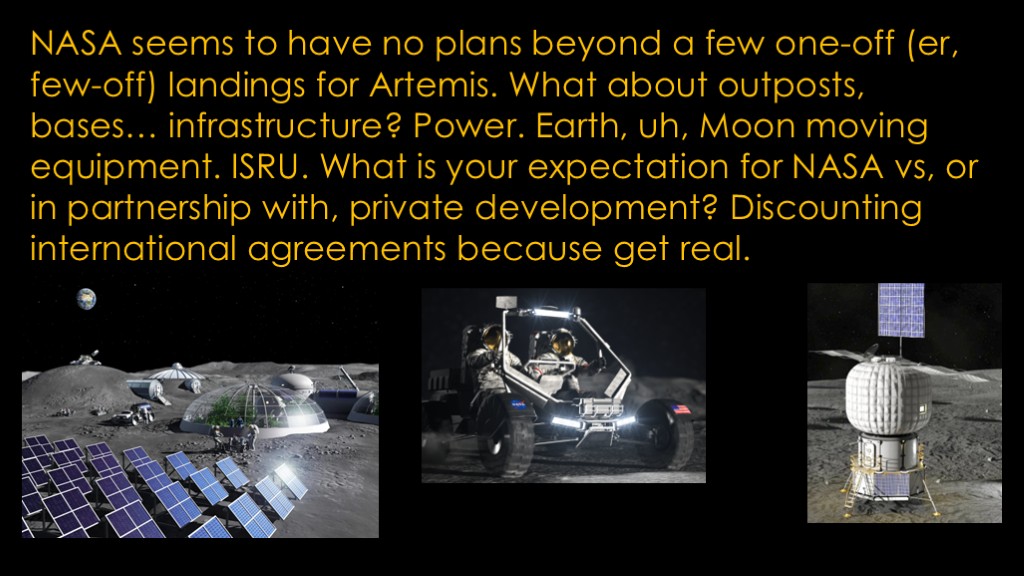
NASA has a document called "the artemis plan" that has some details for what they call the "artemis base camp".
It has a bitchin' lunar side-by-side rover, a foundational surface habitat, and... well, not much else. The habitat might show up in 2033 if one thinks the current artemis schedule is credible.
You'll need a lander to carry these to the surface and since Orion can't put heavy loads into near rectilinear halo orbit and then get home, it will need to come to earth on the lander as well.
Which means getting it there is likely a purely commercial mission. Even with that, I don't think that NASA has the extra bucks to support a lunar base.
https://www.nasa.gov/wp-content/uploads/2020/12/artemis_plan-20200921.pdf
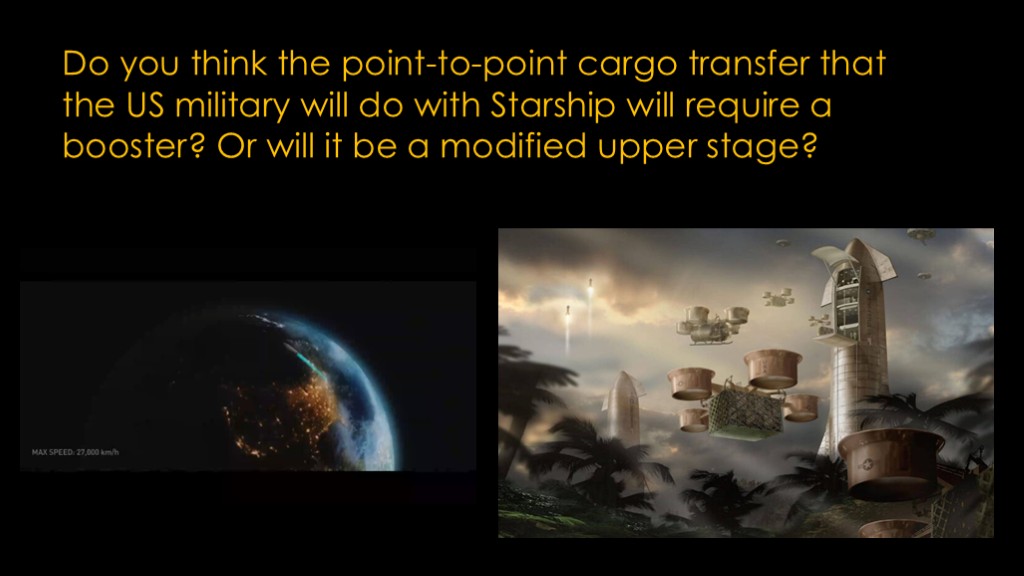
Interesting question.
Until that point, I'll make two observations.
The first is that Starship is a vehicle that is as close to a single-stage-to-orbit as is practical. Super Heavy only adds a minor amount of delta v (aka "oomph") as that minimizes the penalty of landing it back at the launch site.
The second is that while getting into orbit takes about 9400 meters per second of delta v, getting halfway around the world on a suborbital trajectory only takes about 7900 meters per second of delta v.
If you are willing to accept a reduced payload, my guess is that you can do it with just starship, and if you want a lot of payload, you might need the whole stack.
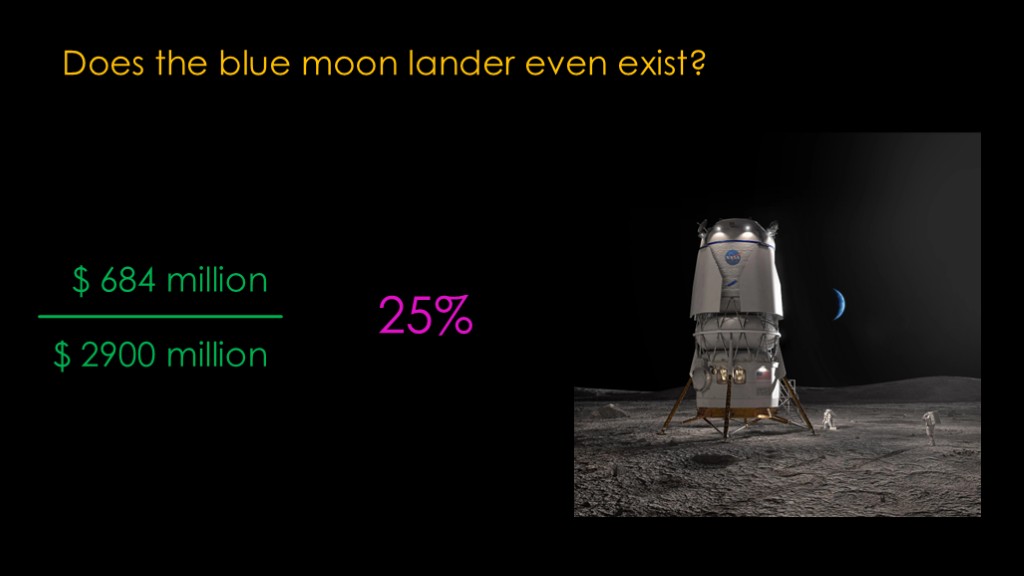
Blue Origin doesn't talk much, so we don't know where they are in the development process. We *do* know that in contracts like these, there are incremental payouts as the company achieves specific milestones, and those are public knowledge. We don't know the actual amounts and I couldn't find much detail about the milestones in the Blue Moon contract.
The current information says that Blue Origin has received $684 million out of a $2900 million contract, and that means they are 25% of the way through.
Which honestly doesn't tell us much.
I should probably note that SpaceX has received pretty much all of the money for the first HLS starship contract. Government contracts generally run for 5 years and since the initial award was in 2021, it makes sense for SpaceX to write a contract that awards most of the money as early as possible. In this case, SpaceX got a separate contract for Artemis IV that runs out in late 2027. It is *possible* to extend these contracts but generally difficult.
My *guess* is that most of that 25% that Blue Origin has been awarded are design studies and reviews that NASA requires, and that means they are likely working on hardware, but no idea how far along they are.
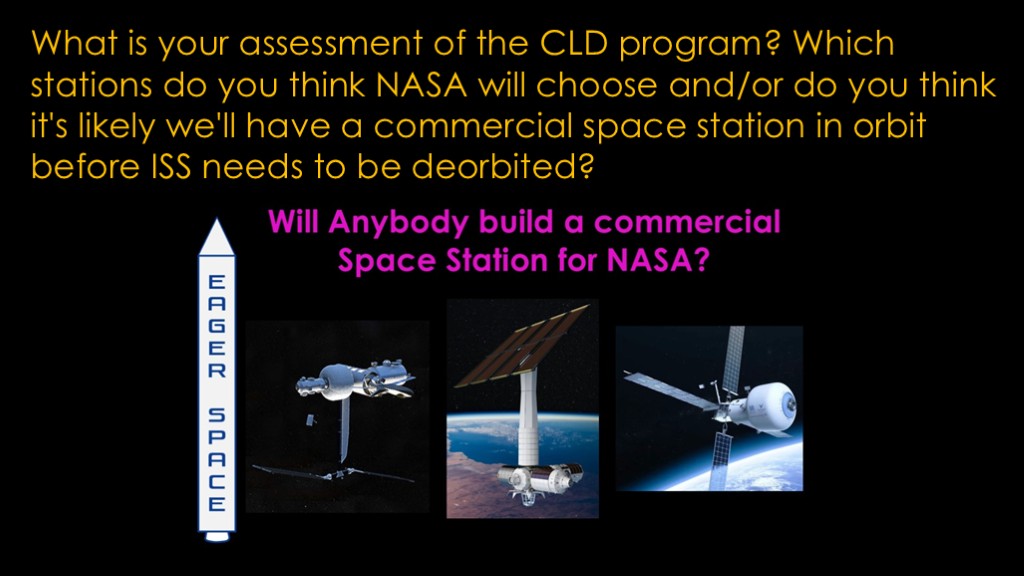
Here's a video for you...
I don't think congress cares about funding this and ISS at the same time - if at all - and I haven't seen anything since I did the video that would encourage me to think that there will be agreement between NASA and the possible suppliers. NASA and congress want something that will be cheaper than ISS and I don't think there's a business model that makes the other stations practical.
I do think that there's a decent chance that Axiom will get their first module up to the ISS before it's time to deorbit and they will somehow inherit all of the really expensive equipment NASA wants to keep in orbit, but it's not clear what their business model is either.
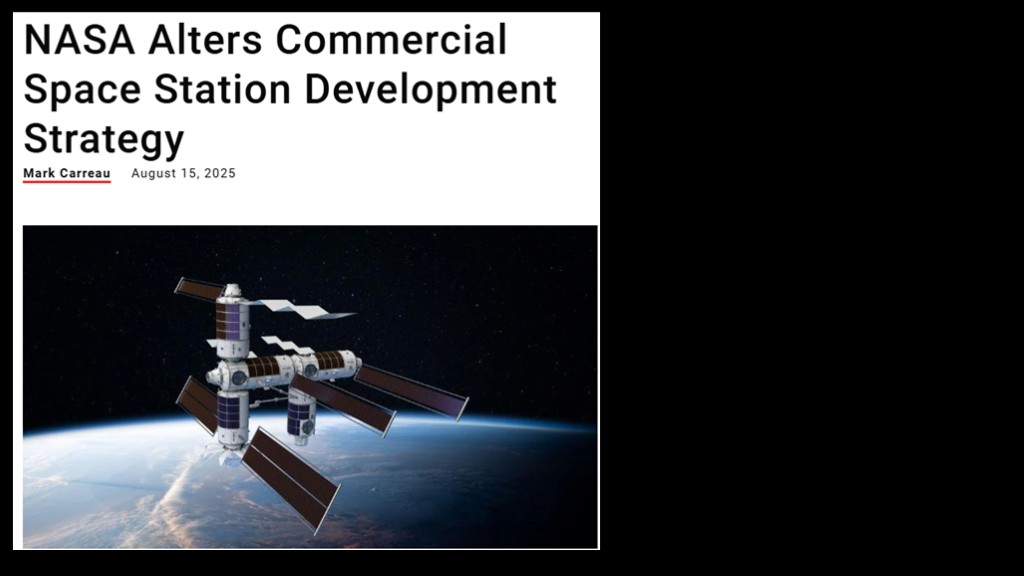
News flash!
Since I wrote that answer, NASA has altered their commercial space station strategy to use the approach that they used for commercial cargo and crew.
Instead of a pure firm-fixed-price approach, they will use space act agreements to pay companies to develop commercial space stations. There will be a separate certification program before NASA will buy space on the station.
They have also reduced the occupational capability from "full" to "4 crew for 1 month increments"
I think this approach is likely to work better, but it's still not clear what Congress will think about this change.
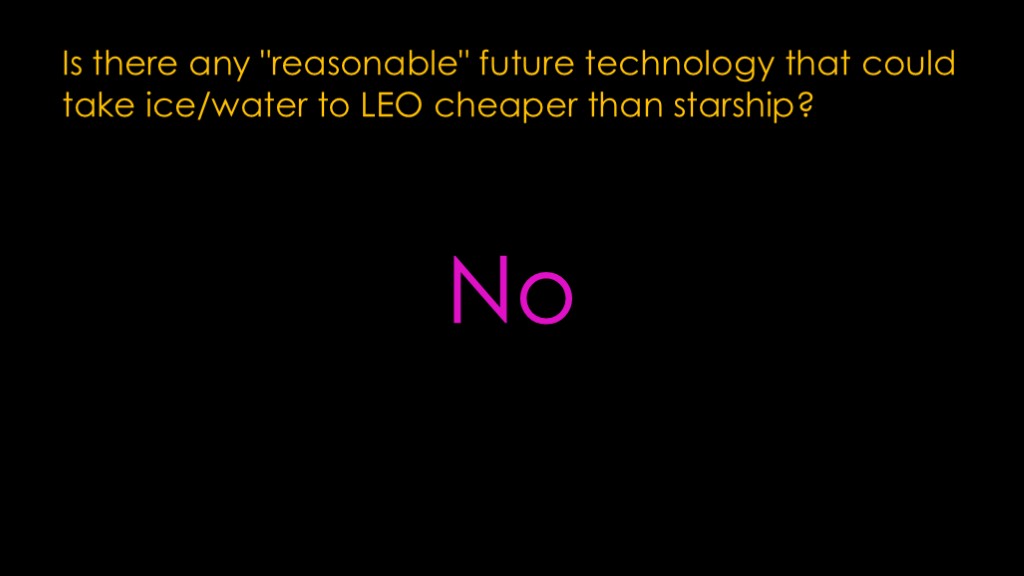
From the earth, no.
We use chemical rockets because they work and none of the more speculative approaches look promising.
From elsewhere, you could do it from the moon and there are a couple of possibilities for getting water from asteroids, but neither are near term.
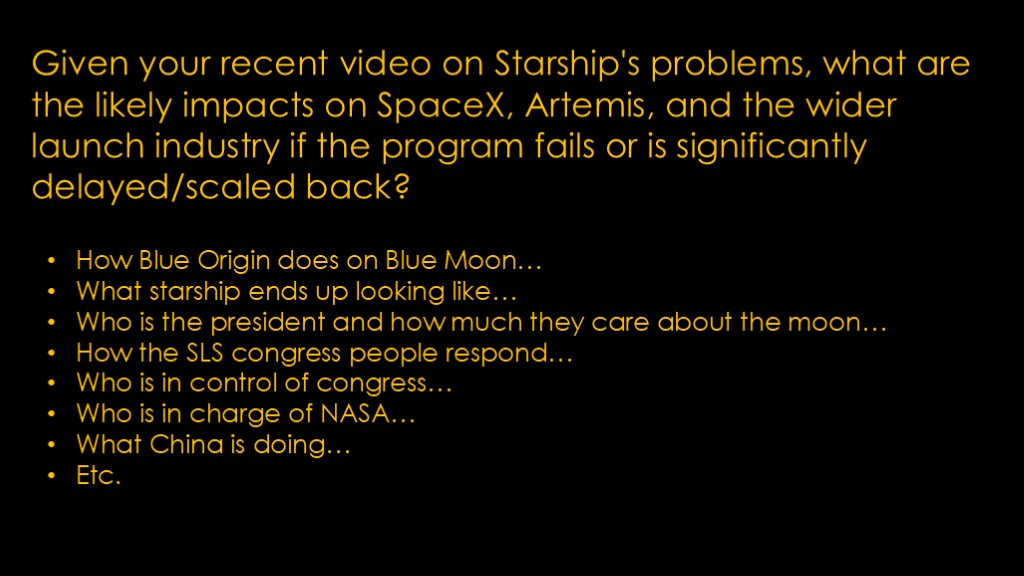
I don't know.
Here is a short list of factors. Give me 5 more minutes and I'll double it.
Too many factors, too many people, too many unknowns. Remember that 6 months ago it looked like SLS might be cancelled after Artemis 3, but right now it looks like the SLS congresspeople might be able to prevent that.
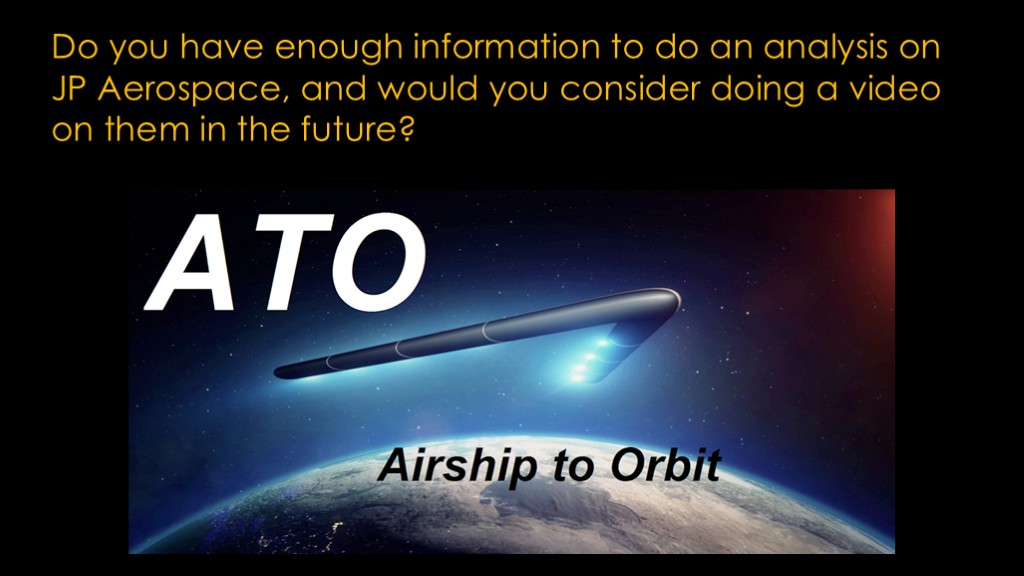
There's not really anything I can comment on - AFAICT there are just a few renderings with very few details.
With the airship to orbit you somehow need to get this very large and high-drag vehicle up to orbital velocity without losing all of your energy to drag. Seems really hard to do.
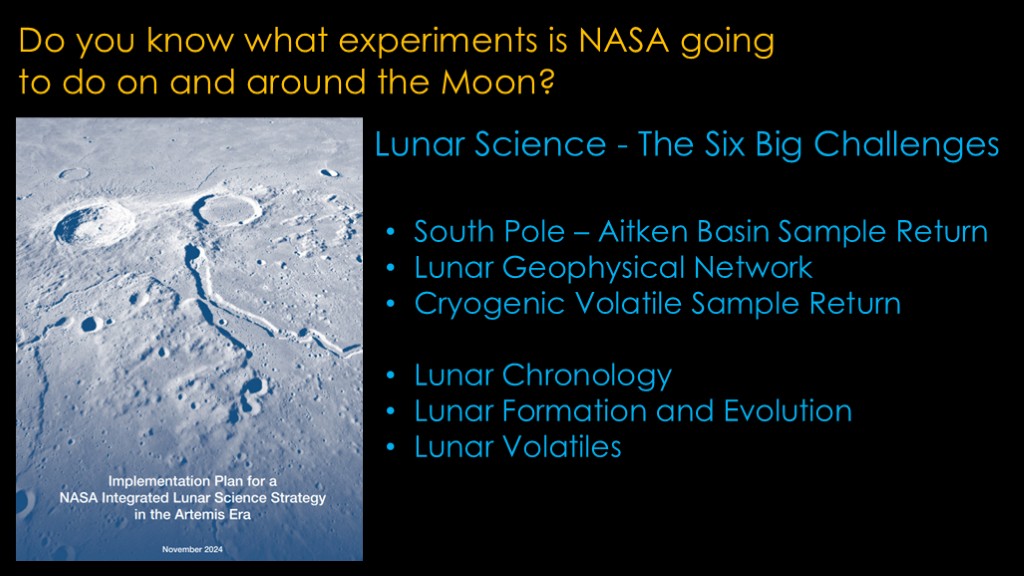
NASA of course has a document that explains this, the implementation plan for a NASA integrated lunar science strategy in the Artemis Era, dated November 2024.
They list six big challenges.
The first three are (read)
The second three are a big more diffuse (read)
https://ntrs.nasa.gov/api/citations/20240015059/downloads/Implementation_Plan_Final_2024.pdf
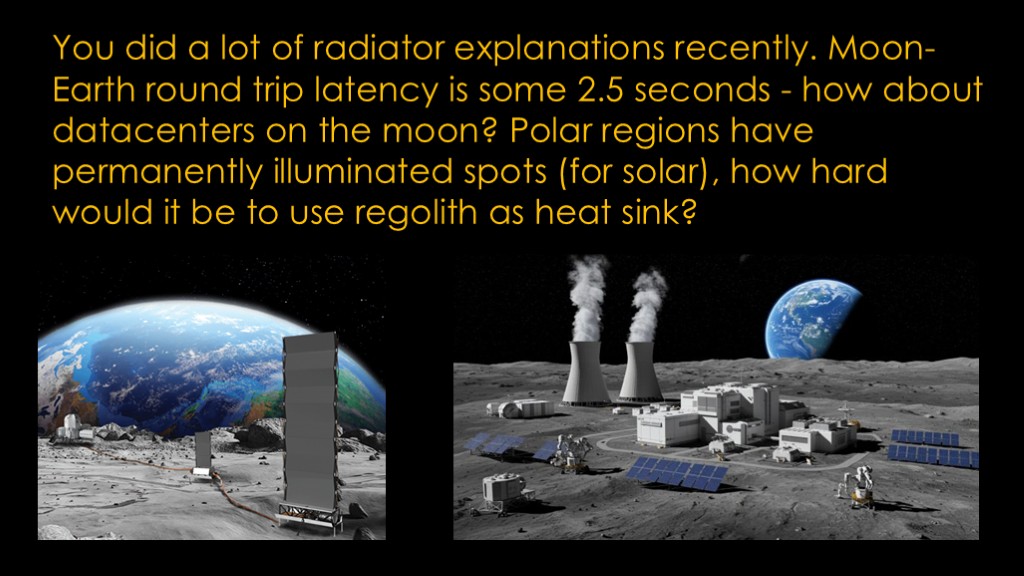
It's possible. The problems are:
You need to get down to the regolith and be able to transfer heat effectively
Deployment is more difficult and you might run into issues at a specific site. We have essentially zero experience at what we might find when we try to dig holes on the moon.
You likely need a pumped fluid system.
Radiators work and just keep working
Mass to the lunar surface is current $1-2 million per kilogram
Radiators are just easier for early systems, and they are probably lighter and cheaper.
Or perhaps we could just do what the innovation new network says the Chinese are going to do.

There seems to be market demand for moon rocks...
It's really hard to get to the moon and back. My guess is that you only get 500 kg or so of lunar rocks back if you launch your (very expensive) lunar return mission on a Falcon Heavy.
$200 million is a decent lower bound for the cost, which means your cost is $400,000 per kilogram and your price is probably double that.
Doesn't seem like there's likely to be much market there.
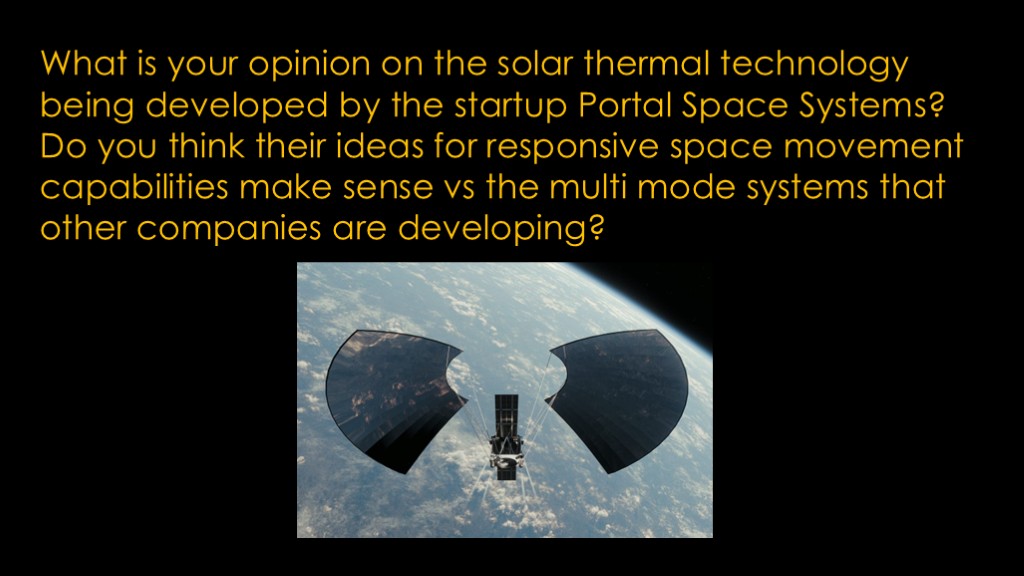
There's probably a full video on solar thermal designs. It's on my list, no idea when I might get to it. The short answer is that I think solar thermal has some possibilities but also some challenges.
I think Portal Space would be better served if they spent a less money on a flashy website and instead wrote a white paper talking about what their concept is, preferably with some calculations in it.
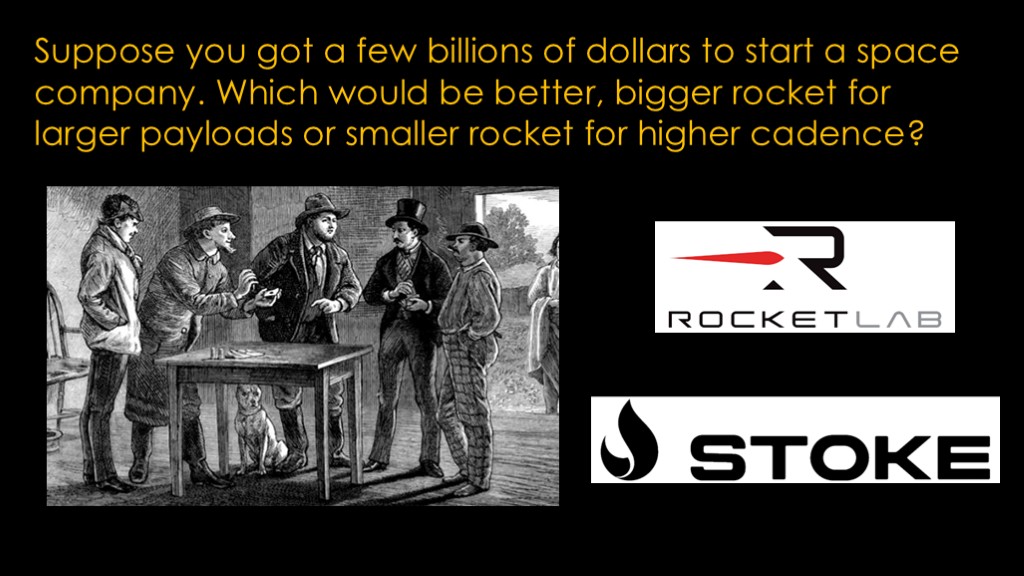
Launch companies are mostly a sucker bet. Rocket Lab and Stoke have a decent chance to offer some competition with SpaceX, and there's no reason to think that anybody else will do as well as they do.
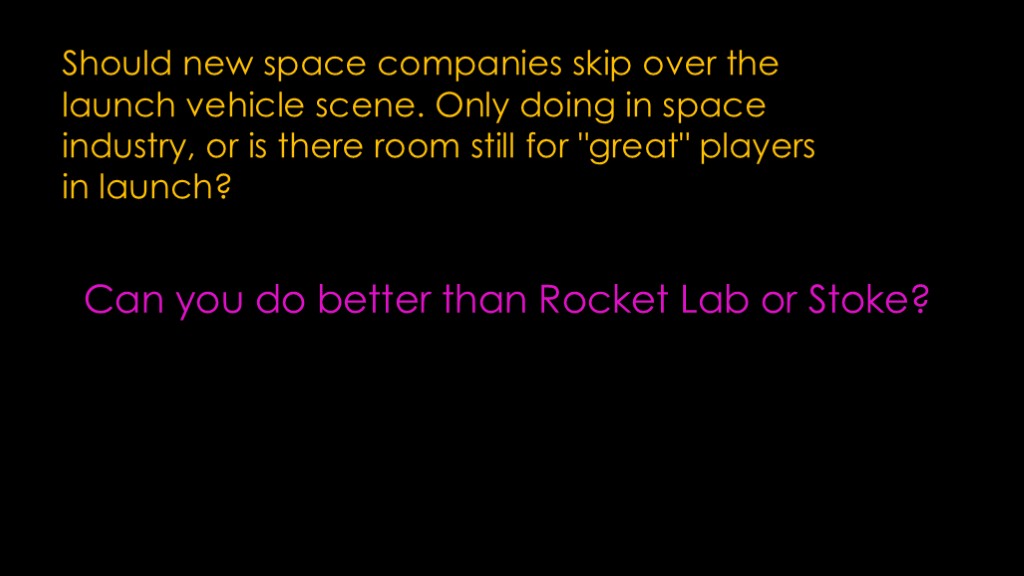
Competition in launch is about fixed costs, incremental costs, and launch rate.
The existing providers have big advantages in that.
Unless you think you can do better than Rocket Lab or Stoke, spend your money elsewhere.
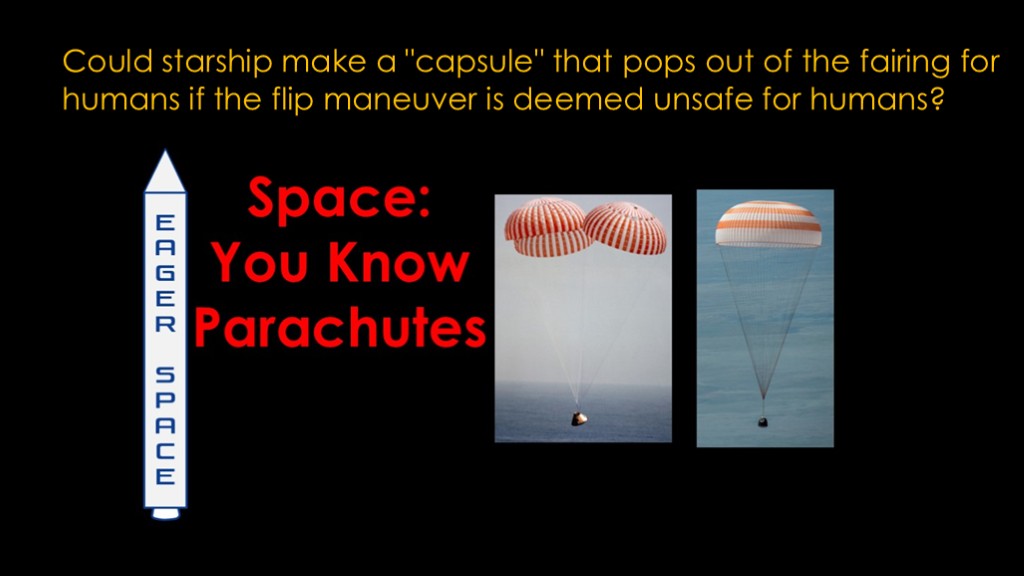
It's possible.
But presumably that capsule would use parachutes and they aren't terribly reliable. Here's a video with more information.
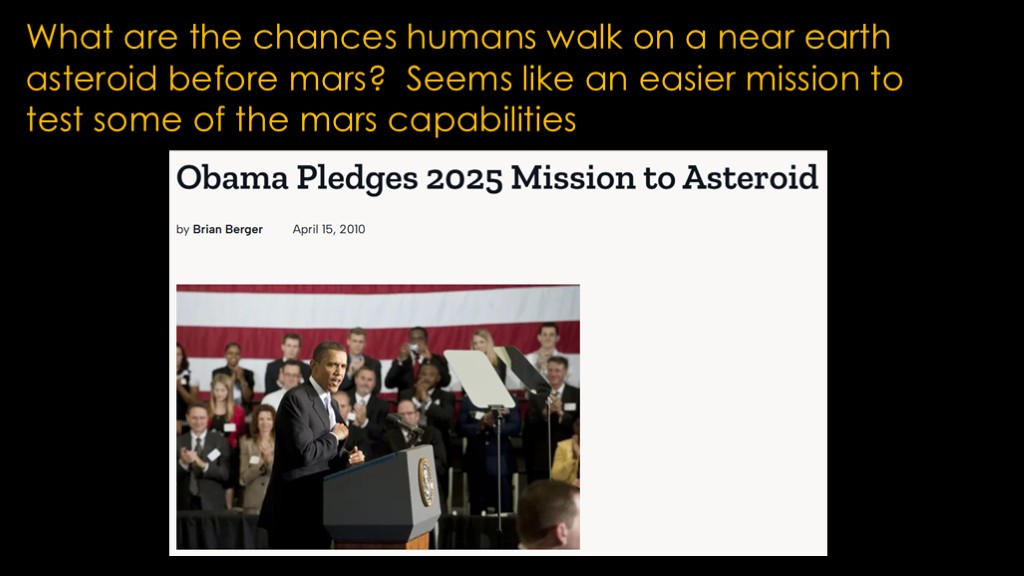
Not many people know that when SLS was first proposed, the mission that President Obama wanted to do was a crewed mission to a near earth asteroid.
Then it - smartly - got changed into a mission to bring an asteroid back to lunar orbit where it could be visited by astronauts. This was required because there was no way that SLS and Orion could get to an asteroid and return.
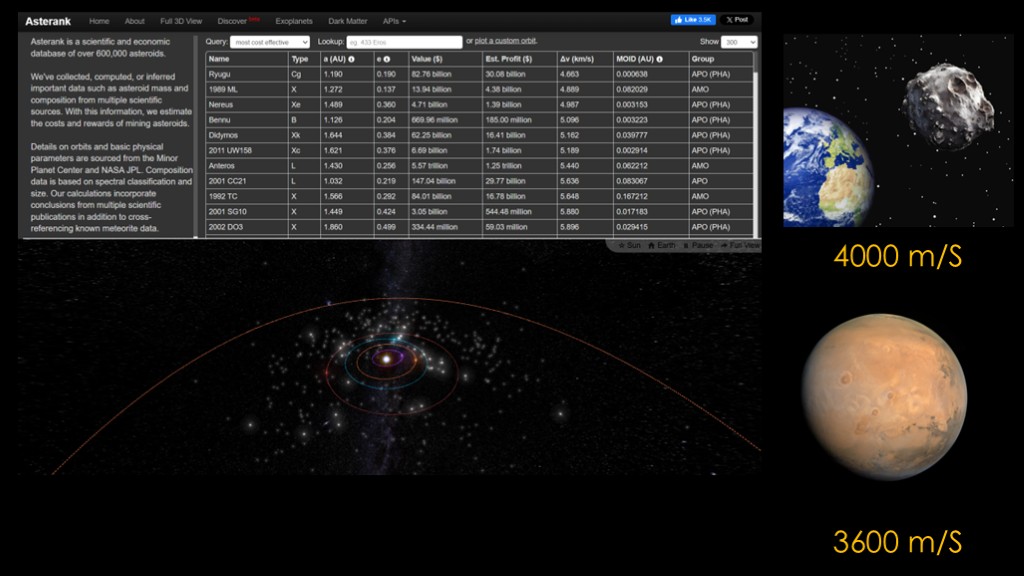
There's a neat site called asterank that lets you browse for different asteroids. There are a few that require less than 4000 meters per second of delta v, but getting to the surface of mars only requires 3600 meters per second of delta v.
I *can* confidently tell you that humans will never walk on a near earth asteroid, because even on the biggest near earth asteroids, gravity is only one one thousandth of a G. If you were a 100 kilogram human, you would weigh only 140 grams.
Not something you can walk in.
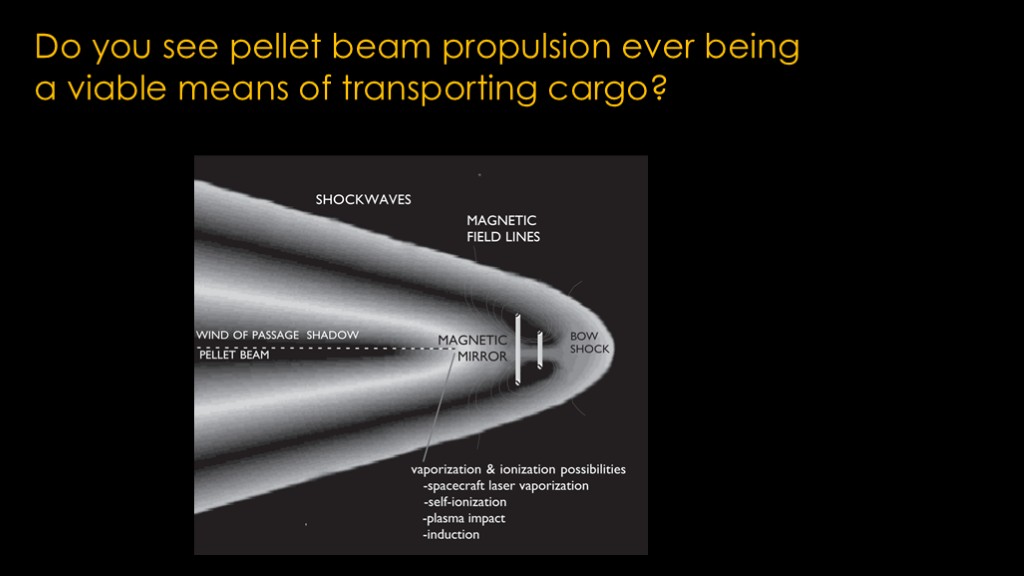
Pellet beams - also known as mass beams - use a small spacecraft with a reflector that you shoot things at. It's a bit like the Orion nuclear bomb spacecraft with pellets instead of bombs. You generate the pellets at earth and fire them at the spacecraft, then the spacecraft has some way of vaporizing the pellets into plasma, which the hits the back of the spacecraft and accelerates it. The advantage is that the spacecraft has no fuel to carry.
The disadvantages are many, and I don't think it's a practical design.
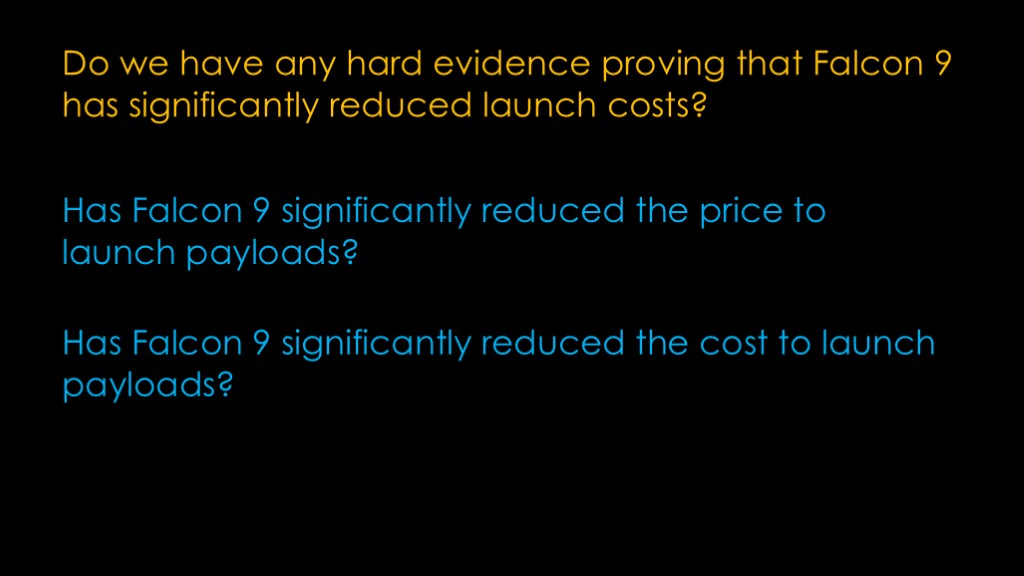
This question referenced a YouTube video that I haven't seen, mostly because writing videos is a better use of my time than watching them and I don't do "response" videos.
There are really two questions lurking here.
The first is whether Falcon 9 has significantly reduced the price to launch payloads.
The second is whether Falcon 9 has significantly reduced the cost of launching payloads.
This question contained a reference to another YouTube video that asserted that Falcon 9 had not reduced launch costs. I don't generally watch other YouTube space channels so I won't list that information here.
It's pretty clear that SpaceX has been much cheaper than the competitors in a lot of safe, cheaper enough that ULA stopped bidding for NASA missions because they couldn't compete. These seems very obvious to me.
If the question is about cost, instead of price, it's clear that reuse is a critical portion of their ability to achieving the flight rate that Starlink requires. If they didn't have booster reuse, they would have to build an extra factory and employ more people to make hundreds of first stages.
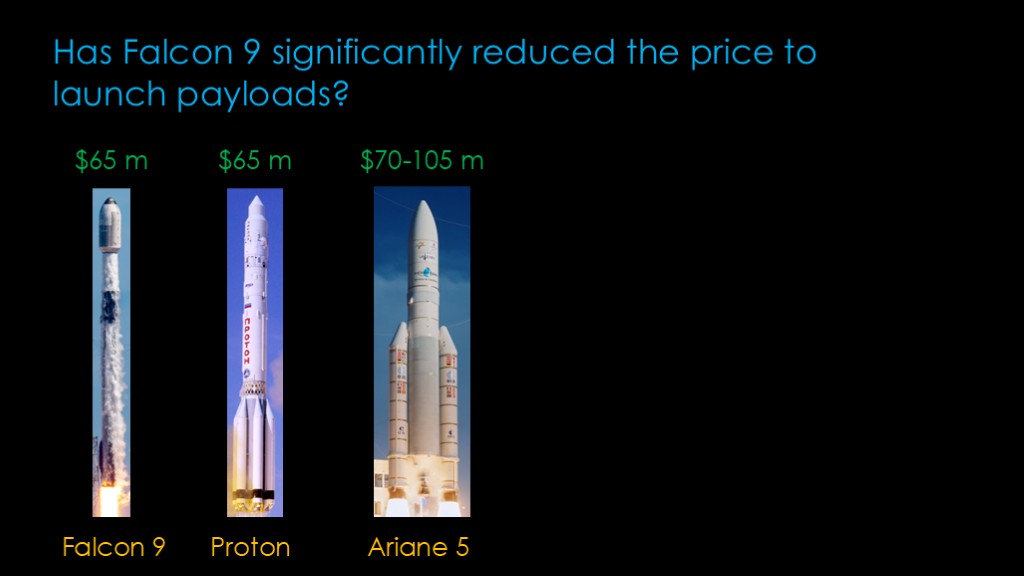
For launch price, I think the question is going to revolve around what you think is a significant reduction in price.
Falcon 9 has been roughly a $65 million rocket for commercial launches.
Price is a very squishy thing in commercial launch as the exact prices are rarely deployed so these are estimates.
Its two main competitors were the Russia Proton, which was also roughly a $65 million rocket, and the Ariane 5, which typically launched two satellites, a lower berth for a smaller satellite at around $70 million and an upper berth for about $105 million
Initially, Falcon 9 was a bit cheaper than Proton's $65 million and it killed Proton because it was cheaper and insurance on Proton was more costly because of its horrible safety record. Easier scheduling was also a factor.
Ariane 5 is a bit more complicated, because it typically launched two satellites, a lower berth for a smaller satellite at around $70 million and an upper berth for about $105 million.
SpaceX undercut both of those prices and was able to attract business away from Ariane 5.
I would say that Falcon 9 was significantly cheaper than Ariane 5 and that led Ariane to reduce their prices.
Remember that SpaceX's goal was to create a successful business, and I think they priced Falcon 9 effectively to do that.
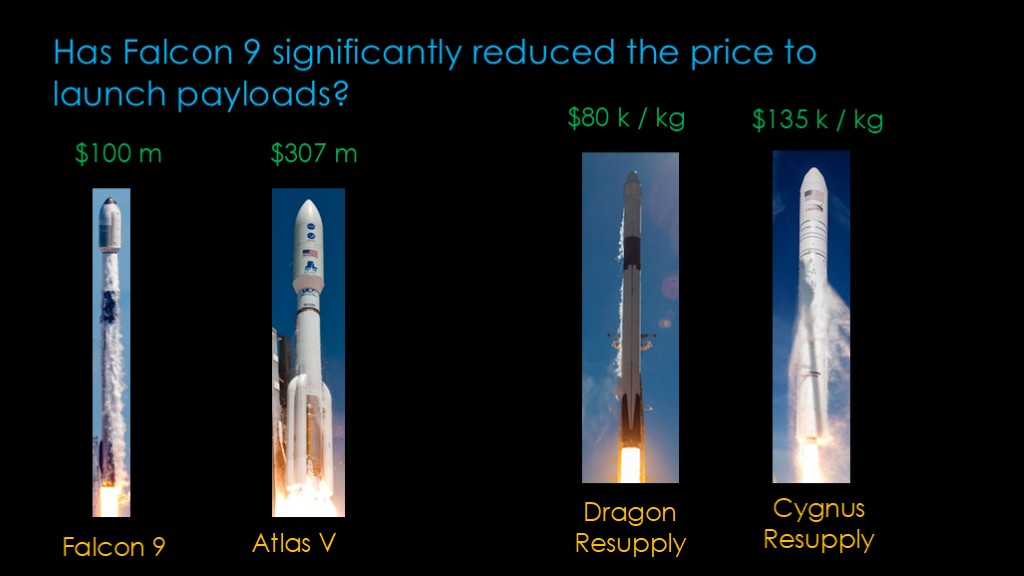
The second market is launches for NASA. For many years, ULA had enjoyed a monopoly on NASA launches.
NASA paid ULA $307 million to launch the perseverance rover on an Atlas V. There's no direct comparable launch, but we do know that Falcon 9 has launched NASA payloads for $100 million, sometimes less.
Since SpaceX was certified for NASA payloads, they have won the vast majority of the contracts.
For initial cargo resupply to ISS, dragon cost about $80,000 per kilogram delivered, while cygnus was about $135,000 per kilogram. Dragon can return materials from ISS while cygnus is a one-way trip. The current cargo dragon pricing is closer to that of cygnus as SpaceX realized they were leaving money on the table. Cargo resupply has been cheaper than shuttle resupply but not by an order of magnitude.
Overall, I would say that the price for NASA payloads has been reduced significantly, especially on NASA science missions.
And I should note that "price" is a really squishy concept be
Comsat launches
NASA planetary missions
NSSL launches
This question contained a reference to another YouTube video that asserted that Falcon 9 had not reduced launch costs. I don't generally watch other YouTube space channels so I won't list that information here.
It's pretty clear that SpaceX has been much cheaper than the competitors in a lot of safe, cheaper enough that ULA stopped bidding for NASA missions because they couldn't compete. These seems very obvious to me.
If the question is about cost, instead of price, it's clear that reuse is a critical portion of their ability to achieving the flight rate that Starlink requires. If they didn't have booster reuse, they would have to build an extra factory and employ more people to make hundreds of first stages.
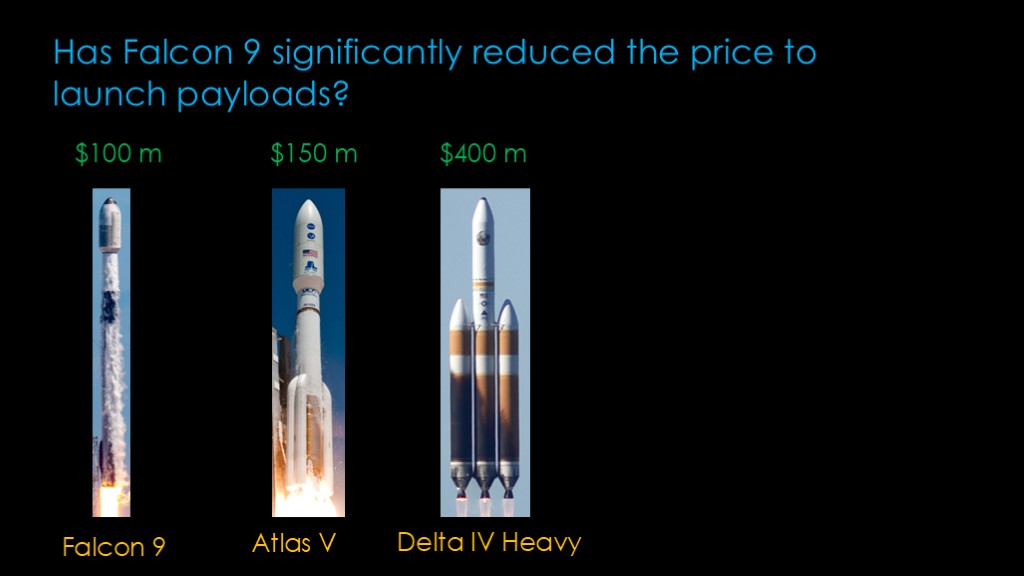
The final market is National Security Space Launches.
Falcon 9 launches were about $100 million per launch. The Atlas V was in the range of $150 million per launch, and the Delta IV Heavy was over $400 million per launch. That is not a misprint, and before SpaceX came along, ULA was getting "launch capability" payments where they would get paid approximately $1 billion per year to be ready to launch government payloads even if no payloads went along.
The existence of Falcon 9 led to the creation of Vulcan and in the current bids, Falcon 9 and Vulcan are roughly equal in price, with ULA working hard to make Vulcan cheaper and SpaceX no longer needing to underprice their launches.
The DoD is ecstatic about Falcon 9; it has saved them tens of billions of dollars in launch costs.
Overall, Falcon 9 has had an impact to lower prices, but it's important to remember that there have been no competitors that have been underpricing what SpaceX charges and therefore they have no incentive to reduce the price of their launches and every incentive to increase their prices to be close to what their competitors will bid.
Because of this, looking at launch prices doesn't tell you much.
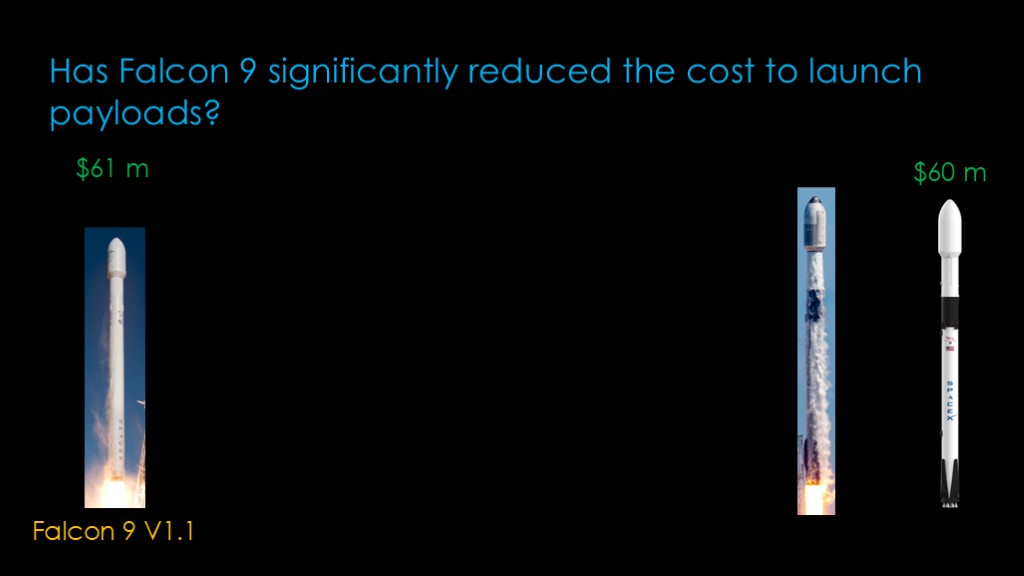
Now let's look at cost...
This is another squishy thing, because you need to not only consider the per-launch incremental cost but the fixed costs that are spread across all the launches in a year, and launch companies have large fixed costs.
Falcon 9's first commercial launch was Cassiope (kass-e-oh-pay) and they charged $61 million, so it's a fair bet that their cost is less than that, because they need launches to generate enough cash flow to allow them to pay for their fixed costs, do additional development work, etc. They were clearly keeping their price low to attract customers - customers who weren't sure about flying with them - but given that their US competition was Atlas V, they likely could have priced higher if they wanted to.
They flew 9 commercial payloads before they were able to land the first booster. There was clearly demand, but they kept their price at about $60 million. That's another indication that their incremental cost was lower than their cost.
But I think the real question is about reuse and its effect on cost
The first observation is that there is no logical reason for SpaceX to go to the trouble of landing boosters and recovering fairings and bring them back to be refurbished and flown again if it doesn't save money, and once SpaceX expended all the block 4 boosters, they have been continually flying boosters.
The second observation is that there is no reason to suspect that SpaceX is spending a ton of money on refurbishment. If you look at the size of their infrastructure at Kennedy Space Center it's just not big enough to support extensive refurbishment.
And that was back before they started flying Starlink, when they were flying 25 ish launches per year. They are now flying over 120 times a year. That means that they have higher utilization of their barges and ships, which makes them cheaper, they have gone to much higher production of falcon 9 second stages, which makes them cheaper, and they are spreading their fixed costs across 120 launches rather than 25.
There is no world in which the cost of a Falcon 9 launch today isn't much cheaper than the early Falcon 9 launches.
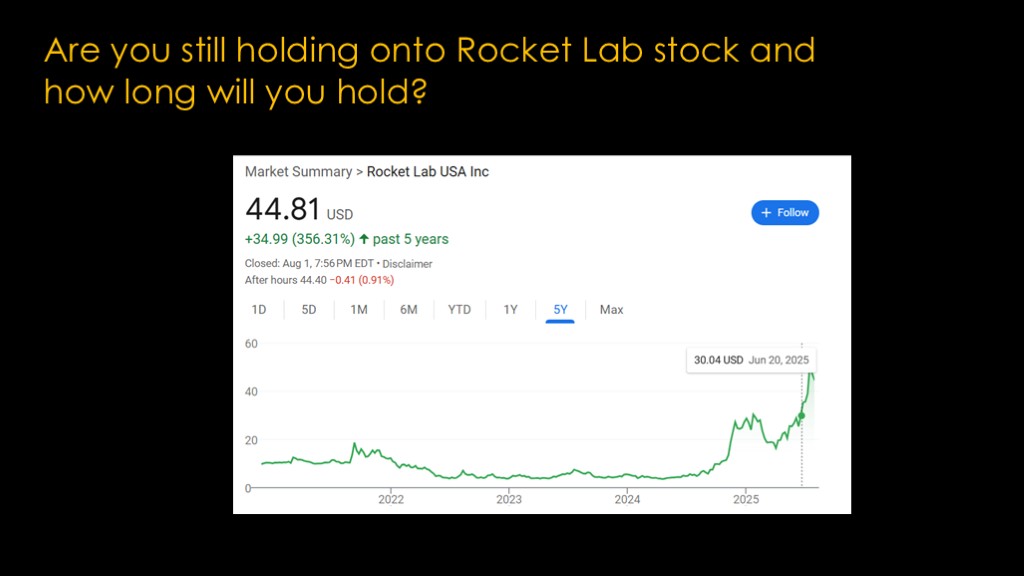
Yes.
I'm generally a follower of Warren Buffet who said, "the best time to sell a stock is never", but the real answer is that I hold onto stocks until I think the reasons that I bought the stock no longer apply.
And my rocket lab holding is what I call "amusement scale" - it's not enough money to result in much change in my finances whatever happens.
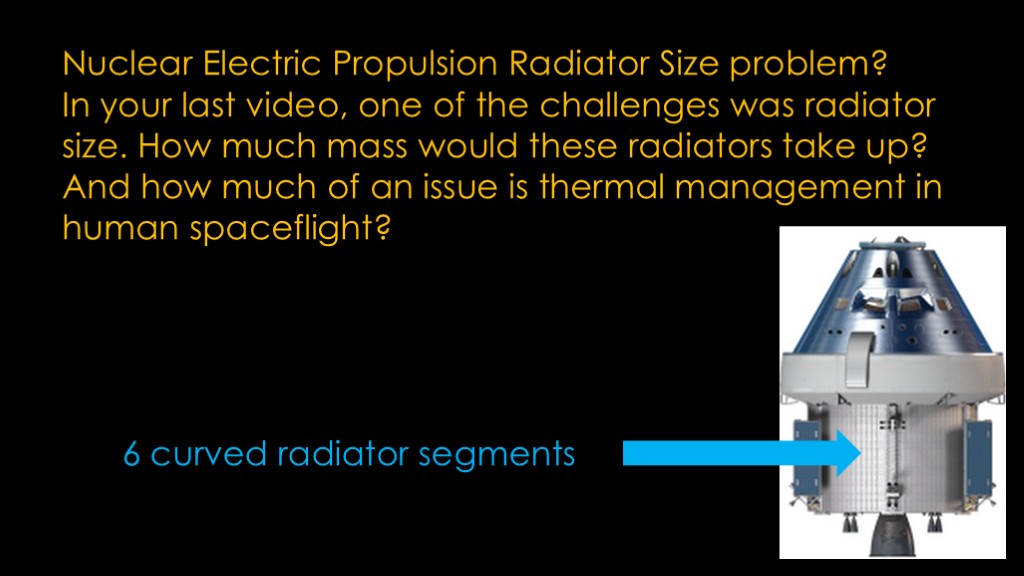
You can look at one of the studies I linked to in the video description for more details.
ISS needs decent sized radiators, and shuttle needed to use the payload door radiators to stay cool.
In Orion, the outer wall of the service module consists of 6 curved radiator segments.
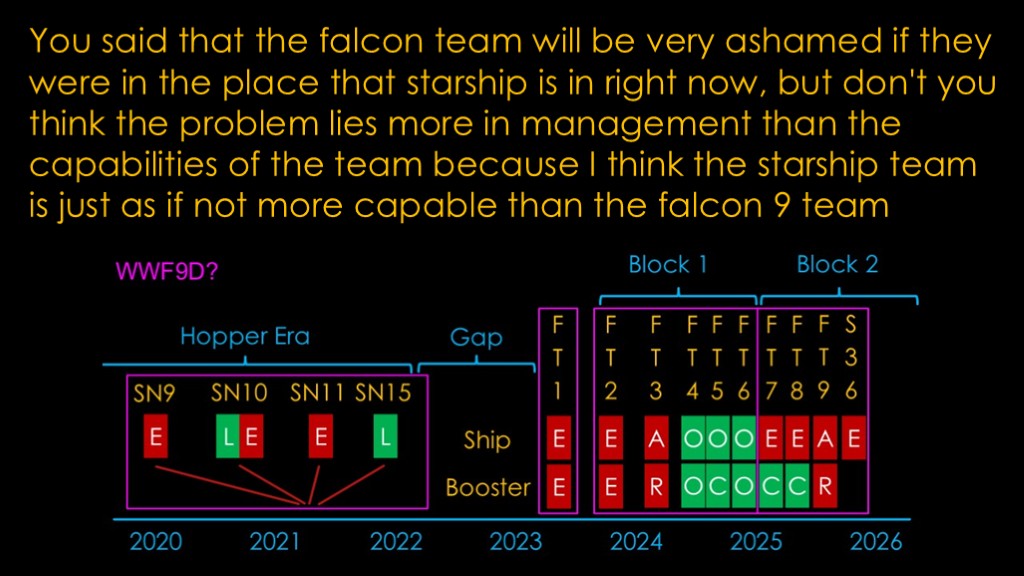
I actually said "embarrassed" rather than "ashamed".
Capability is measured by demonstrated track record.
The starship team looked pretty good through the hop tests and okay at block 1. They haven't demonstrated progress in block 2.
This isn't to say that there aren't very talented people on the team. Merely that they are not making forward progress, and that's the only way to measure capability.
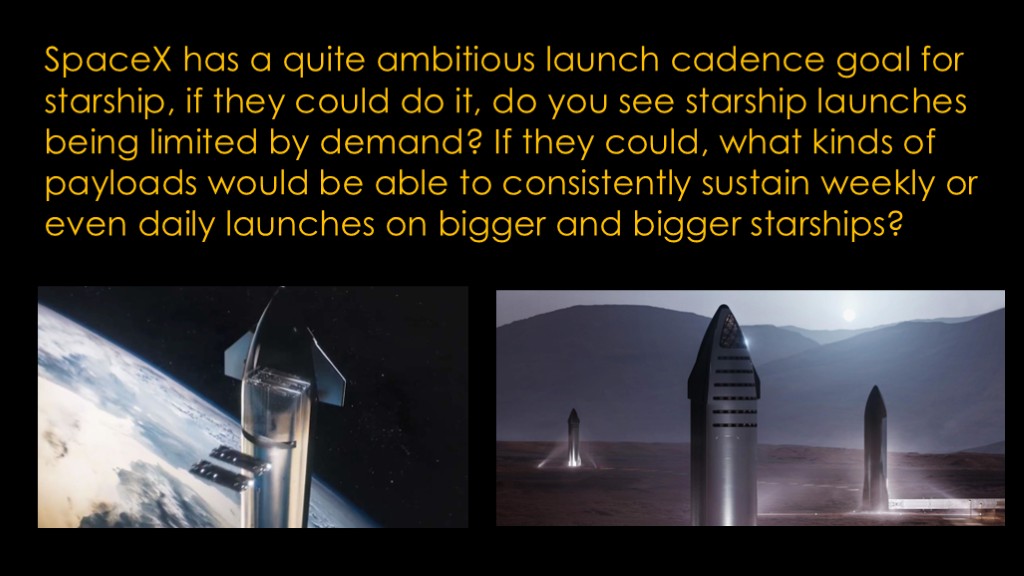
With the exception of Starlink and Mars missions, Starship is a solution looking for a problem and that's unprecedented in the launch and satellite industry.
It's not clear to me what companies will make of that capacity.

Look at NASA's space mission design tools page.
GMAT looks like a good place to start, and you can find it on SourceForge
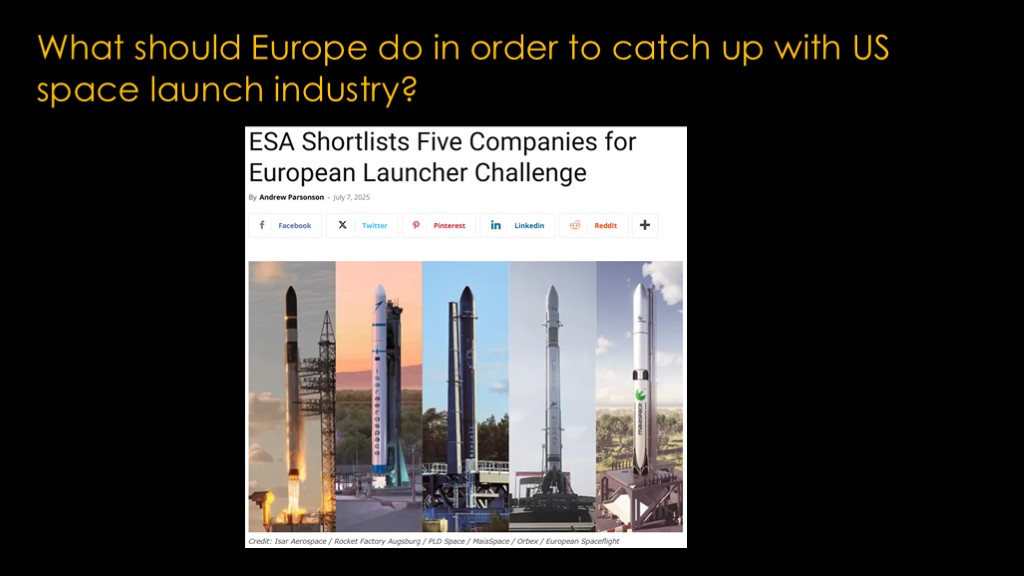
The European launcher challenge is a decent start, where ESA has said they will buy flights on these new launchers.
The development isn't funded by ESA - it needs to be funded by the nation where the company is located, which means they aren't really "European" launchers, they are member country launchers.
They did this to avoid the long discussions that ESA has whenever they try to do anything, because each country wants to get something back for the money they are putting into it, but it seems fairly likely that there will be some countries who win and others who lose, and that is likely to strain the ESA relationships.
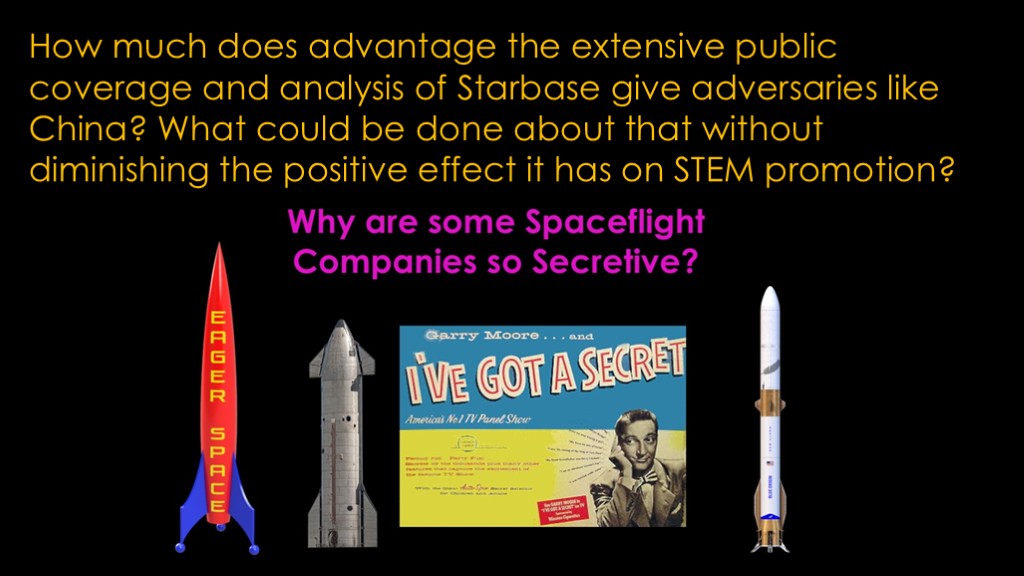
Most of your questions are answered in this video.
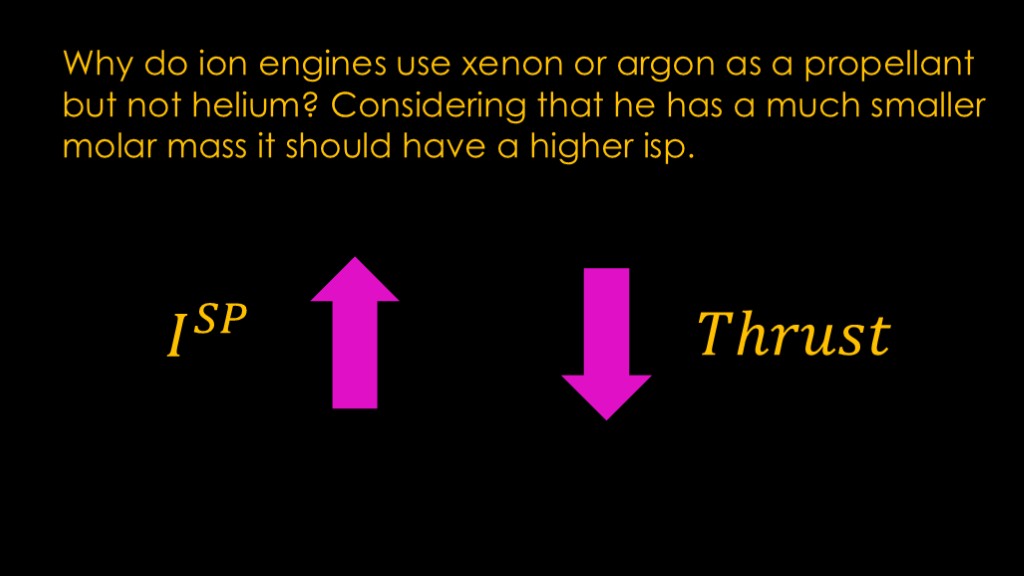
This is a fun one because the answer is counter-intuitive.
As specific impulse goes up, thrust goes down, and for ion thrusters the thrust is already very small.
You are correct that helium would give a much higher specific impulse - roughly 6 times the specific impulse you would get with Xenon. That means that your engine is much more fuel efficient, but your thrust would be 1/6th amount, and you need *much* larger tanks because the density of Xenon is 33 times the density of helium.
You have a hyper-efficient thruster that uses almost no fuel but it takes forever to get there.
If you want the math, there's a link to a reddit post in the video description.
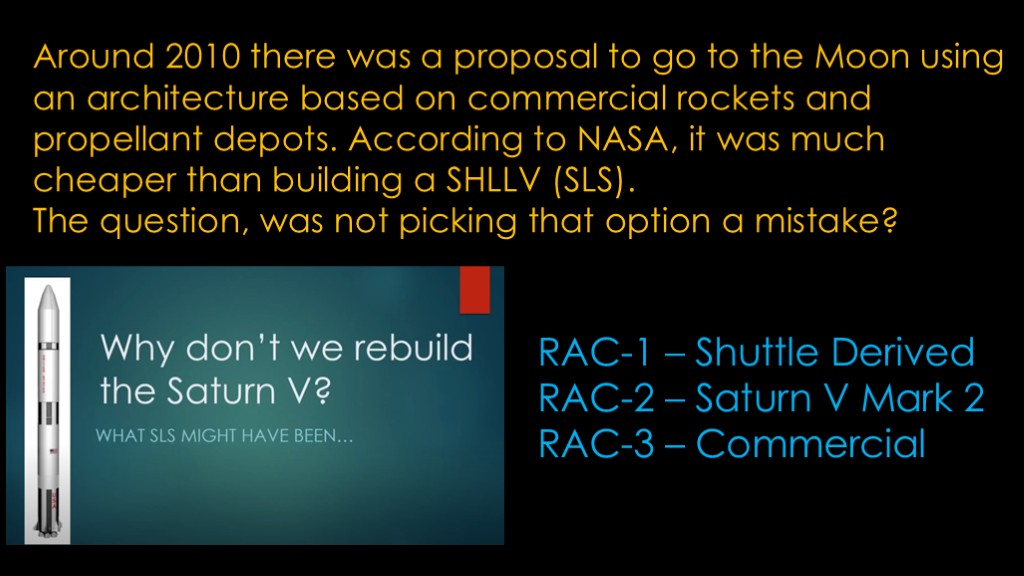
I talk about this a bit in one of my early videos.
At the start of SLS, NASA spun up three teams to look at options. The RAC-1 team would look at shuttle derived versions, the RAC-2 would look at a new design that I call Saturn V mark 2 because it was mostly an uprated Saturn V, and RAC-3 looked at commercial design.
RAC-2 was the winner technically, though there were some concerns you can find listed in the video.
But the "competition" was a charade because the 2010 space act required NASA to use existing shuttle technology, and that's why we ended up with the kind of program we wanted.
This wasn't a mistake on the part of Congress - they didn't care about exploration, their directive was "build a big ass rocket that could maybe be used for some yet-to-be-defined mission in the future". They cared about keeping the money that had flowed during 30 years of shuttle flights flowing, at least as much as possible.
I looked at the RAC-3 information that was available when I did the video, and the architecture was based on Atlas V and Delta IV. It probably would have been better than SLS but ULA was a really expensive solution so it might not have been great, and there was much more complexity.
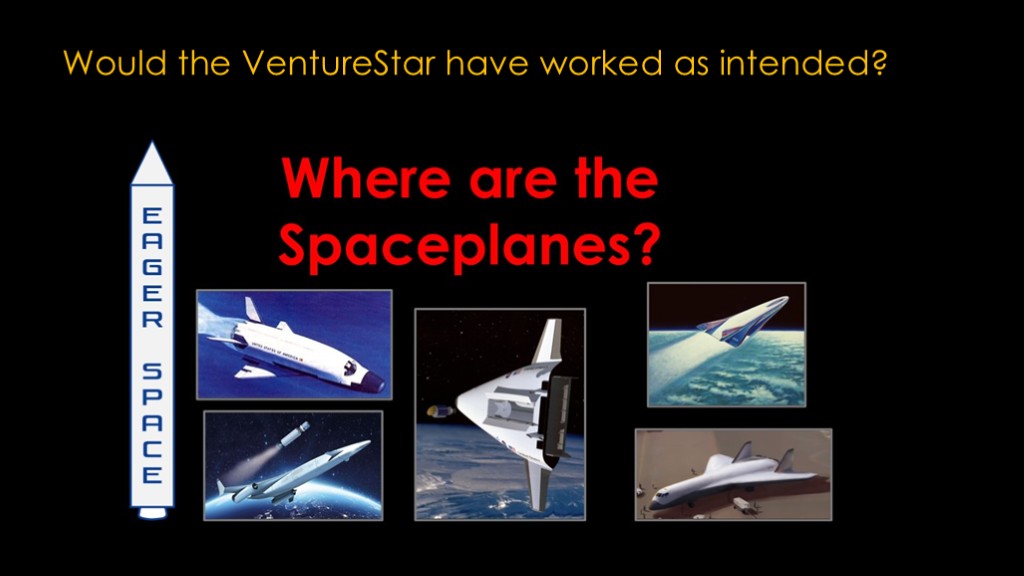
No. This is a video on spaceplanes that explains why.
Note that while there are companies that are happy to take other people's money to develop spaceplanes, nobody is lining up to spend their own money.
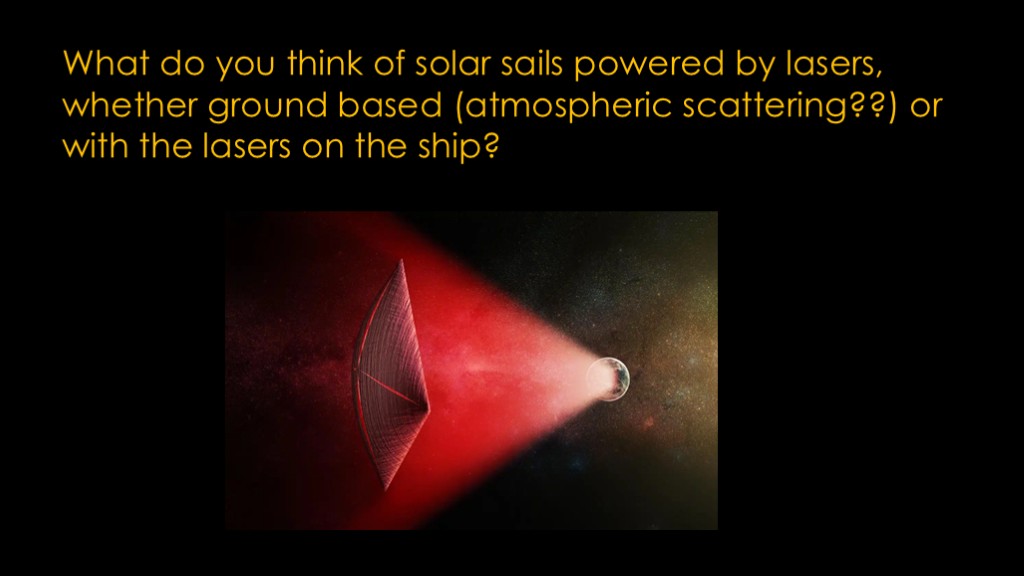
I think the problems are:
Power density. Rocket engines produce really high power levels and high power laser aren't cheap and powerful enough.
Loss of power as you get farther away due to inverse square law.
There are some designs that will probably work, but they involve very small spacecraft and 100 megawatt laser arrays.
See Breakthrough Starshot for one such concept.
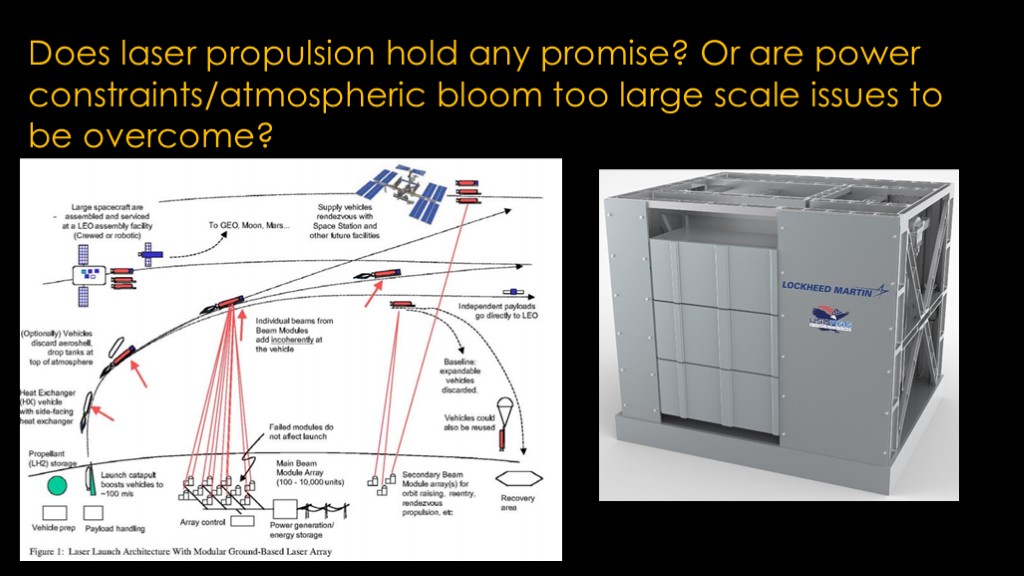
I think the power density requirements are really, really high.
The calculations I've seen suggest that a Falcon 9 is putting out about 26 gigawatts of power.
The most powerful continuous laser seems to be the one Lockheed Martin is building that is a 500 kilowatt laser. Though that may be the input power rather than the beam power.
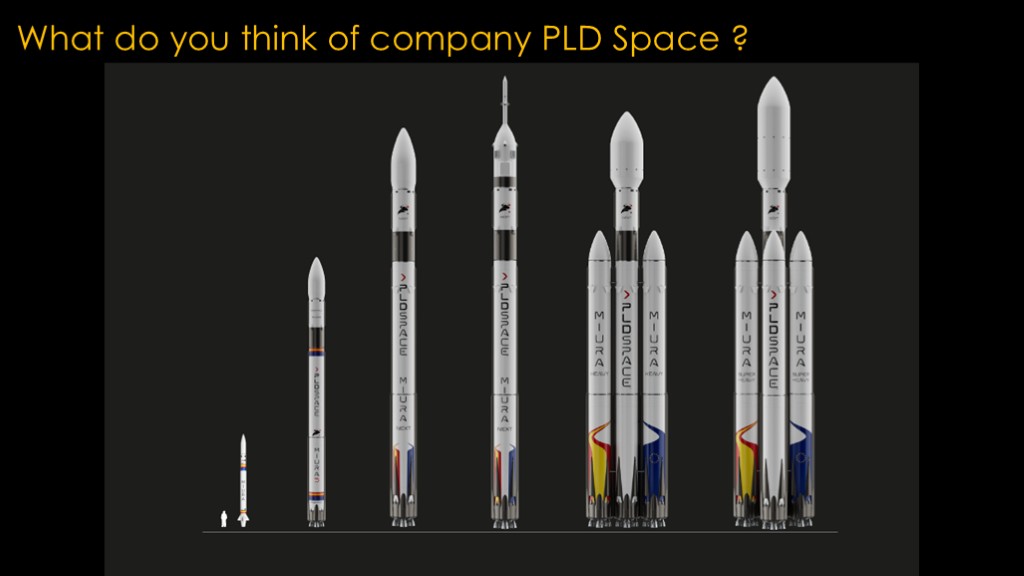
They are one of 5 companies selected under ESA's European launcher challenge, but they will likely need to convince the Spanish government to provide funding under that program.
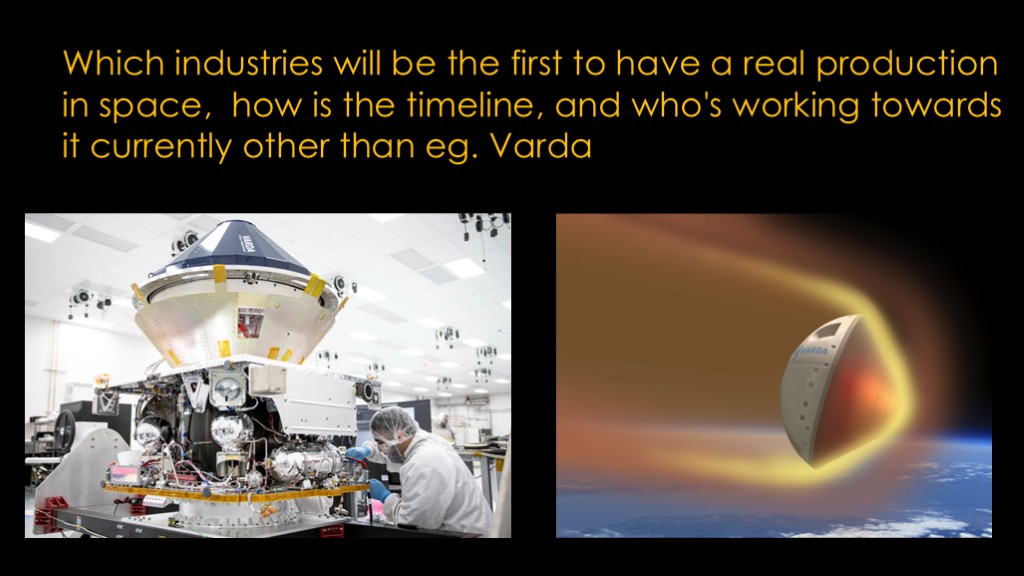
That's a question NASA has tried to answer for decades on the ISS, and it isn't clear if there is actually a market there, at least at current launch costs.
Varda is starting as small as practical to discover what market there is, and so far it seems to be working...
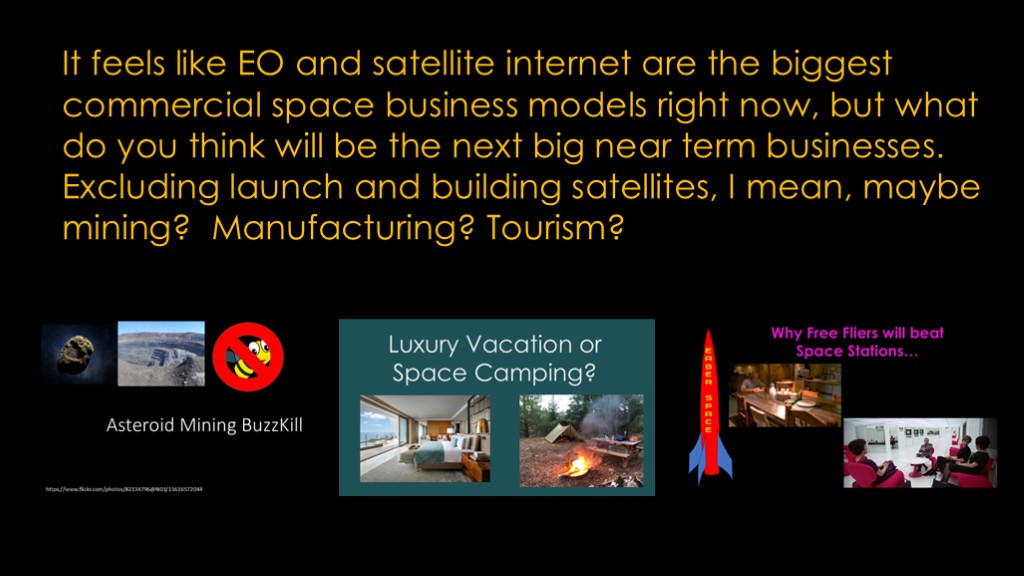
Three videos for you.
The short answer is that earth observation and communications are the proven markets. Launch right now is still probably too expensive for manufacturing.
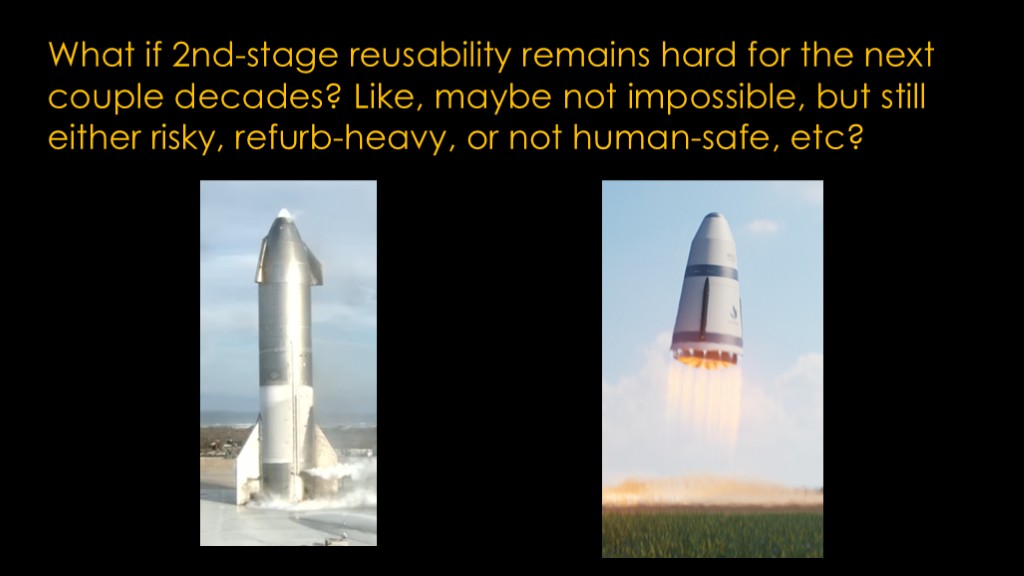
If second stage reuse doesn't work, then we're stuck with first stage reuse and companies will optimize for that.
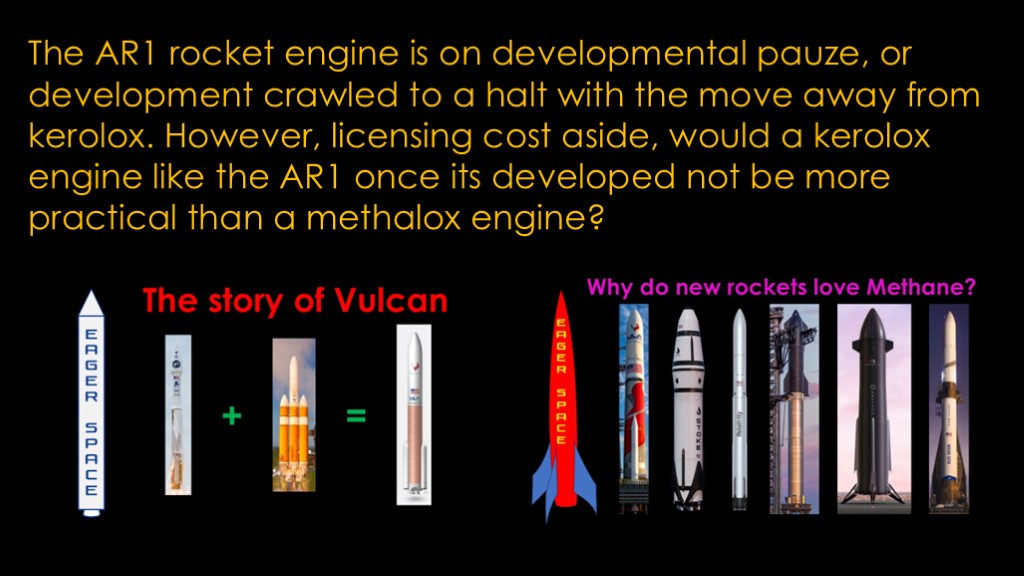
Two videos for you to watch.
Methane is better from a reusability standpoint and likely cheaper in cost, though propellant costs don't matter until you get to full reuse.
But it's interesting that ULA decided to go with the unproven Blue Origin engine development team rather than Aerojet rocketdyne, though the last high performance engine that Aerojet rocketdyne built was the RS-25 for the space shuttle in the 1970s and now for SLS.

Thanks to everybody who asked questions.
If you've gotten this far, you might want to take a trip to eagerspace.net, where you can all the past videos and the scripts for most of them.

If you enjoyed this video, listen to this...
https://www.youtube.com/watch?v=V83JR2IoI8k